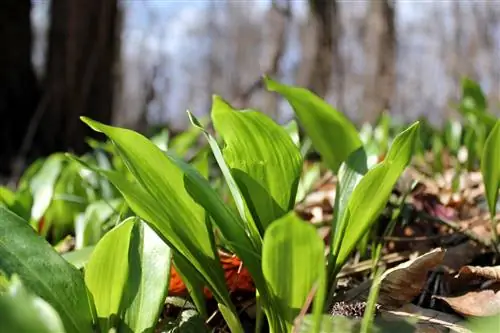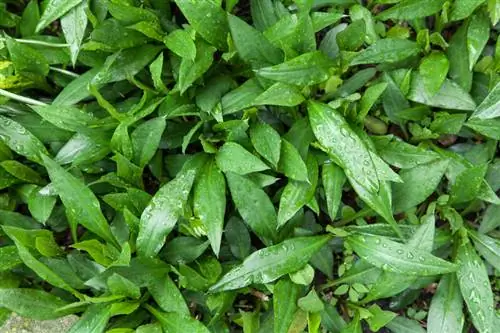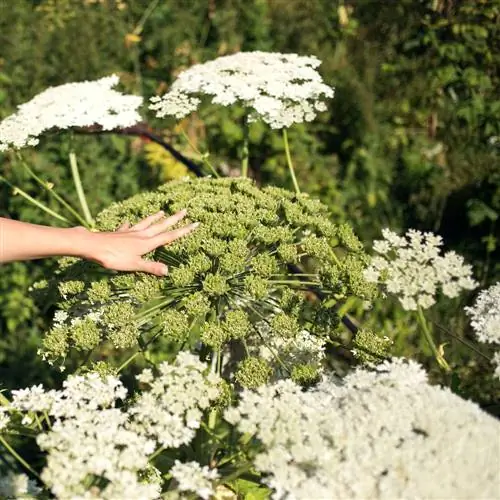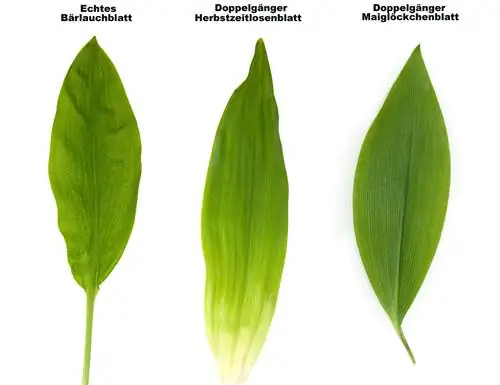- Author admin [email protected].
- Public 2023-12-16 16:46.
- Last modified 2025-01-23 11:22.
Wild garlic (Allium ursinum) attracts numerous collectors to the forests in spring. Wild forest garlic not only tastes wonderful, but is also very he althy. These features will help you recognize the plant and distinguish it from its poisonous counterparts.
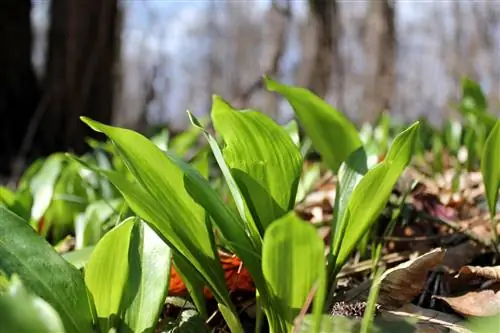
What characteristics can you use to recognize wild garlic?
You can definitely recognize the leaves of the wild garlic becauseeach leaf grows individually directly from the ground- there is only one leaf per stem on the wild garlic, whoseUndersideis alsomatt. Also noticeable are thepronounced leaf scaron the underside and the intensescent of garlic
Which plants look similar to wild garlic but are poisonous?
Why is it so important to recognize wild garlic by its characteristics? Because there are three very similar but poisonous plants that often grow nearby and can cause serious poisoning if mixed up. These include:
- Lily of the valley (Convallaria majalis)
- Autumn crocus (Colchicum autumnale)
- Spotted Arum (Arum maculatum)
While lily of the valley and autumn crocus are very common and form large populations together with wild garlic, the arum has become very rare. Nevertheless, you should be able to distinguish between the plants: The arrow-shaped leaves, which only appear in spring, are typical of the arum.
How do wild garlic differ from lily of the valley?
Lily of the valley leaves always grow out of the ground in twos or sometimes threes on a stem, so they can be easily distinguished from wild garlic. In addition, lilies of the valley do not have a matte top, but a shiny one. A reliable distinction is also possible based on the flowers: the bell-shaped, white lily of the valley flowers appear lined up on a curved flower stalk, while up to 20 wild garlic flowers form a rounded flower ball. The wild garlic flowers are also white, but star-shaped with six petals each. If you want to cultivate wild garlic in the garden, you should definitely not plant these two species together or even close together.
How can you tell the difference between wild garlic and autumn crocus?
Especially to avoid confusion with the deadly poisonous autumn crocus, you should be able to recognize wild garlic with certainty. These characteristics are typical for the leaves of the autumn crocus:
- grow loose from a rosette (not individually!)
- are colored light green
- shiny
- slightly curled leaves
- barge-shaped tip
- Foliage leaves thick and stiff (those of wild garlic are rather thin and slightly limp)
The crocus-like, pale pink to purple flowers of the autumn crocus appear in autumn, while the leaves always only emerge in the following spring.
Can you identify wild garlic by smell?
Basically, wild garlic can be recognized very well by its smell, because thestrongly reminiscent of garlic scent does not have the neutral-smelling, poisonous counterparts. So you can take a leaf between two fingers, rub it lightly and then do the smell test. If the leaf smells like garlic, it is definitely wild garlic.
ButCaution: This test can only be carried out on one leaf because theodor persists stubbornly on the fingers and on subsequent ones Samples can no longer be reliably distinguished.
Tip
What happens if you eat the wrong wild garlic?
It is particularly dangerous to confuse it with the autumn crocus, which contains the deadly poison colchicine. Even around 50 grams can be fatal! Although lily of the valley or arum is not fatally poisonous, it can cause severe diarrhea, vomiting and violent cramps.

